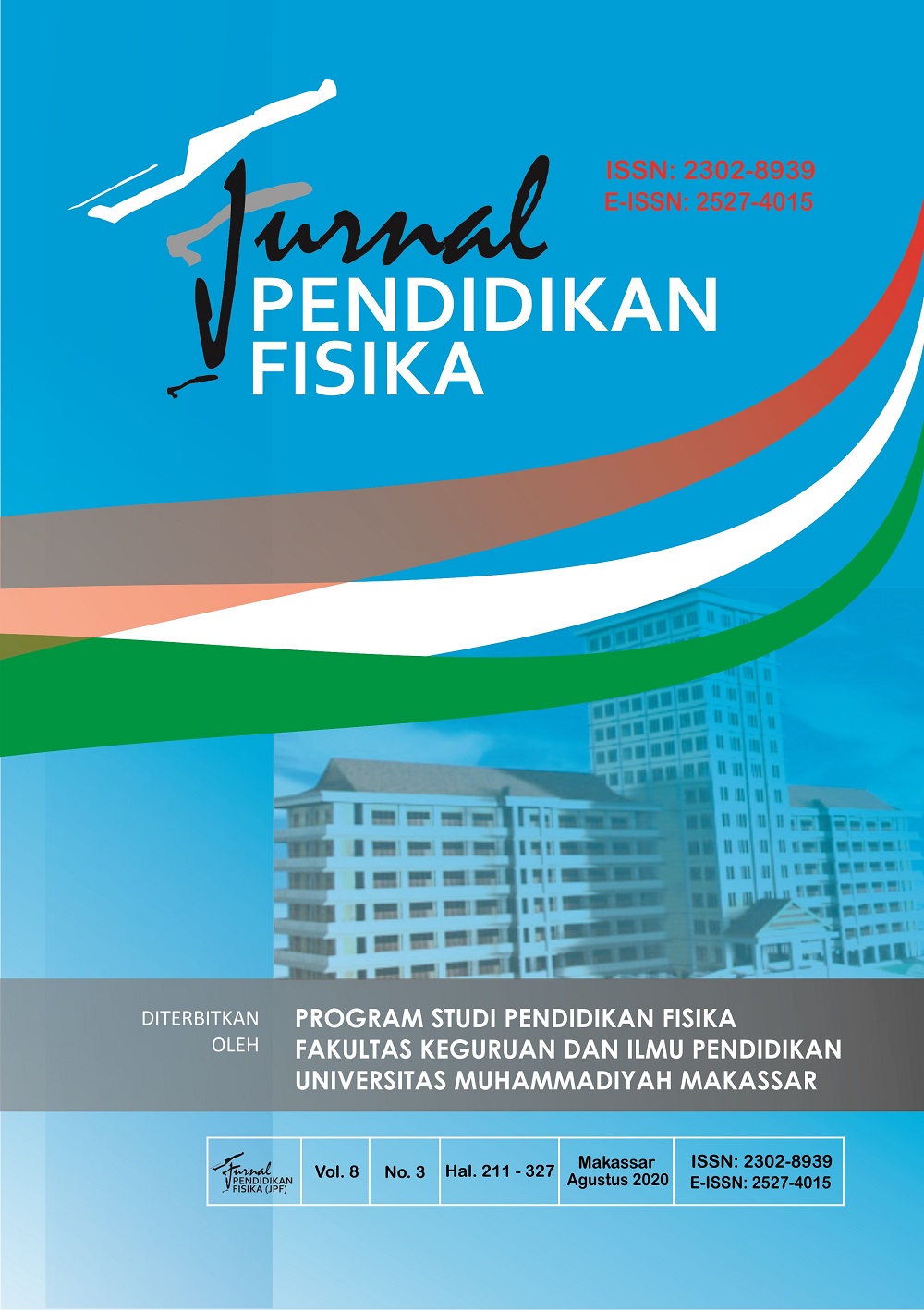The Implementation of Cognitive Conflict Learning Strategy in Efforts to Reduce Heat Misconception in Junior High School Students
DOI:
https://doi.org/10.26618/jpf.v8i3.3950Kata Kunci:
Cognitive Conflict, Misconception, HeatAbstrak
The most misconceptions in learning physics originate from the students themselves which include the students' initial concepts, associative and humanistic thinking, wrong intuition, the stages of students' cognitive development, and students' abilities. The purpose of this study was to determine the profile of heat misconception in junior high school students after learning by using the TGT cooperative learning model with cognitive conflict strategies. The research design used in this study is One group pre-test and post-test design. The data collection instrument was a misconception test in the form of a Three-tier Test totaling 20 questions. The results showed that before the treatment of the five junior high schools had an average percentage of misconceptions of 54.37%. After learning using the TGT cooperative learning model with cognitive conflict strategies the average percentage of students' misconceptions is 37.58%. Thus, there was a decrease in the percentage of misconceptions by 16.79%. The conclusion of this study is the TGT cooperative learning model with cognitive conflict strategies can reduce heat misconception in junior high school students in Lamongan District.Referensi
R. R and D. H. Marisda, “The Effectiveness of Experimental Method in Teaching Motion Topic at Senior High School Level,” J. Pendidik. Fis., vol. 8, no. 1, pp. 33–42, 2020, doi: 10.26618/jpf.v8i1.3004.
I. S. Budiarti, U. Negeri, and S. Maret, “Profil Pembelajaran Suhu dan Kalor di SMA Se-Kabupaten Keerom,” vol. 4, no. 1, pp. 22–24, 2017.
Haryono, H. E. (2018). The Effectiveness Of Science Student Worksheet With Cognitive Conflict Strategies To Reduce Misconception On Heat Concept. Jurnal Pena Sains, 5(2), 79-86.
Nana, “Penggunaan Pendekatan Konflik Kognitif Untuk Remediasi Miskonsepsi Pembelajaran Suhu Dan Kalor,” Semin. Nas. Pendidik. SAINS “Mengintregasikan Nat. dan Nurtur. untuk Memberdayakan HOTS di Era Disrupsi,” pp. 8–14, 2018.
M. Başer, “Effect of conceptual change oriented instruction on remediation of students ’ misconceptions related to heat and temperature concepts,” J. Maltese Educ. Res., vol. 4, no. 1, pp. 64–79, 2006, doi: 10.1061/(ASCE)0733-9410(1991)117.
E. Hadi and A. Yani, “Identifikasi Miskonsepsi Materi Fisika Suhu Dan Kalor Menggunakan Cri ( Certainty of Response Index ) Pada Peserta Didik Kelas Xi Mia Sma Negeri 8 Bulukumba,” no. 1991, pp. 44–54, 2018.
E. V. Berg, Miskonsepsi Fisika dan Remediasi. Salatiga: Universitas Satya Wacana, 1991.
S. Paul, Miskonsepsi dan Perubahan Konsep dalam Pendidikan Fisika, Gramedia W. Jakarta, 2013.
H. Ekawati and R. Hasanah, “Turnamen Belajar Pada Pokok Bahasan Kalor Dan Perubahan Wujud Zat Terhadap Hasil Belajar Siswa Kelas X SMA Negeri 3 Lamongan,” pp. 44–50.
S. M. Alfisyahrina Fitria, Tomo Djudin, “Remediasi Miskonsepsi Siswa pada Materi Suhu dan Kalor Menggunakan Model PBL di MAN,” J. Pendidik. dan Pembelajaran, 2014.
M. Suhu and D. A. N. Kalor, “perpustakaan.uns.ac.id digilib.uns.ac.id Penerapan Model Pembelajaran Kooperatif Tipe,” 2015.
V. A. Sugiawati, “Penggunaan Strategi Konflik Kognitif dalam Pembelajaran TPS untuk Mereduksi Miskonsepsi Siswa pada Materi Termokimia,” J. Nalar Pendidik. Vol. 1, Nomor 1, vol. 1, no. 1, pp. 26–31, 2013.
N. W. Adnyani, I. W. Sadia, and I. N. Natajaya, “Ditinjau Dari Gaya Kognitif Siswa Kelas X Di SMA Negeri 1 Bebandem Ni Wayan Adnyani , I Wayan Sadia , I Nyoman Natajaya Program Studi Administrasi Pendidikan Program Pascasarjana Universitas pendidikan Ganesha,” vol. 4, 2013.
E. Kristianti, Penerapan Pendekatan Konflik Kognitif Sebagai Upaya Mengatasi Miskonsepsi Pada Siswa Kelas VIII SMP N 10 Tegal Dalam Pembelajaran Pokok Bahasan Cahaya. 2011.
M. Ibrahim, Konsep, Miskonsepsi dan Cara Pembelajarannya. Surabaya: Unesa University Press, 2012.
S. N. Wahidah S., S. Kusairi, and S. Zulaikah, “Diagnosis Miskonsepsi Siswa SMA di Kota Malang pada Konsep Suhu dan Kalor Menggunakan Three Tier Test,” J. Pendidik. Fis. dan Teknol., vol. 2, no. 3, p. 95, 2017, doi: 10.29303/jpft.v2i3.295.
Unduhan
Diterbitkan
Terbitan
Bagian
Lisensi
Copyright:
Authors who publish with this journal agree to the following terms:
1. Authors retain copyright and grant the journal right of first publication with the work simultaneously licensed under a Creative Commons Attribution-ShareAlike 4.0 International License that allows others to share the work with an acknowledgement of the work's authorship and initial publication in this journal.
2. Authors are able to enter into separate, additional contractual arrangements for the non-exclusive distribution of the journal's published version of the work (e.g., post it to an institutional repository or publish it in a book), with an acknowledgement of its initial publication in this journal.
3. Authors are permitted and encouraged to post their work online (e.g., in institutional repositories or on their website) prior to and during the submission process, as it can lead to productive exchanges, as well as earlier and greater citation of published work.
Licence:
Authors are free to:
1. Share: Copy and redistribute the material in any medium or format
2. Adapt: Remix, transform, and build upon the material for any purpose, even commercially.
The licensor cannot revoke these freedoms as long as the authors follow the license terms, which include the following:
1. Attribution: You must give appropriate credit, provide a link to the license, and indicate if changes were made. You may do so in any reasonable manner, but not in any way that suggests the licensor endorses you or your use.
2. ShareAlike: If you remix, transform, or build upon the material, you must distribute your contributions under the same license as the original.
3. No additional restrictions: You may not apply legal terms or technological measures that legally restrict others from doing anything the license permits.
Jurnal Pendidikan Fisika is licensed under a Creative Commons Attribution-ShareAlike 4.0 International License.

